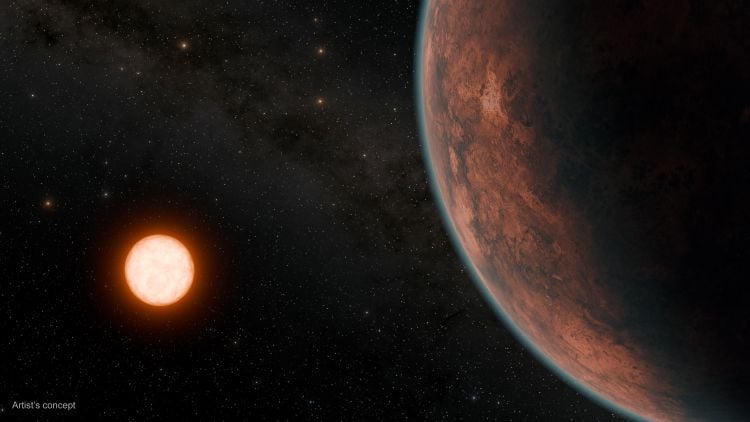The discovery of GJ 12 b marks a significant milestone in exoplanetary science. This Earth-sized world, orbiting a remarkably quiet M dwarf star just 40 light-years away, presents an unprecedented opportunity to understand the evolution and habitability of planets around the most common type of star in our galaxy. Its unique characteristics position it as a prime target for in-depth atmospheric studies, potentially unraveling secrets about how planets retain or lose their atmospheres, and ultimately, what conditions are necessary for life to emerge beyond our solar system.
Gliese 12 – A Quiet M Dwarf
Gliese 12 (also known as GJ 12 or TOI-6251) is a cool red dwarf star located in the constellation Pisces. M dwarfs are the most prevalent stellar type in the Milky Way, accounting for approximately 75% of all stars. They are significantly smaller and cooler than our Sun, with masses ranging from about 0.08 to 0.6 solar masses and surface temperatures between 2,100 K and 3,900 K. Gliese 12 itself is about 27% the size of the Sun and has a surface temperature roughly 60% of the Sun’s.
One of the most crucial aspects of Gliese 12, distinguishing it from many other M dwarfs, is its “quiet” nature. Many M dwarfs are known for their high magnetic activity, leading to frequent and powerful flares of X-ray and ultraviolet radiation. Such stellar storms can strip away planetary atmospheres, rendering planets inhospitable even if they reside within the star’s habitable zone. However, observations of Gliese 12 indicate a lack of extreme flaring behavior. This relative calm significantly enhances the prospects for GJ 12 b to have retained an atmosphere, making it a compelling candidate for habitability studies. The long lifespans of M dwarfs, which can burn for trillions of years, also provide ample time for life to potentially evolve if suitable conditions persist.
Exoplanet: GJ 12 b
Discovered in May 2024 by two independent international teams of astronomers using data from NASA’s Transiting Exoplanet Survey Satellite (TESS) and other facilities, GJ 12 b quickly garnered attention due to its Earth-like size and its host star’s mild disposition. The planet orbits Gliese 12 every 12.8 days, a tight orbit that places it significantly closer to its star than Earth is to the Sun – only about 7% of Earth’s orbital distance.
GJ 12 b is estimated to be comparable in size to Earth or slightly smaller, potentially akin to Venus in our solar system. Initial mass constraints placed it at less than four times Earth’s mass. More recent studies in 2025 have provided refined mass measurements, suggesting it could be around 0.71 to 0.95 Earth masses. Combined with its radius, this implies a density that is comparable to or even higher than Earth’s, strongly suggesting a rocky composition similar to our inner solar system planets.
Despite its close proximity to Gliese 12, GJ 12 b’s equilibrium temperature (assuming no atmosphere) is estimated to be around 42 degrees Celsius (107 degrees Fahrenheit). This is hotter than Earth’s average surface temperature but cooler than Venus. The planet receives about 1.6 times more energy from its star than Earth does from the Sun, and about 85% of the energy Venus receives from our Sun. This energy balance positions GJ 12 b intriguing close to, or slightly inside, the inner edge of its star’s habitable zone, where liquid water could potentially exist on its surface if an atmosphere is present.
Quest for an Atmosphere: Crucial Step Towards Habitability
The presence and composition of an atmosphere are paramount to a planet’s habitability. An atmosphere can regulate surface temperature, protect against harmful radiation, and facilitate the existence of liquid water. GJ 12 b’s proximity to its star means that it could have experienced significant atmospheric erosion during its early, more active stellar phase. However, the “quiet” nature of Gliese 12 in its current main-sequence phase offers hope that GJ 12 b might have retained a substantial atmosphere, or even developed a secondary one through volcanic outgassing.
Scientists are particularly interested in whether GJ 12 b possesses an atmosphere akin to Earth’s, a thick, Venus-like atmosphere, or even no atmosphere at all. Each scenario would provide invaluable insights into planetary evolution around M dwarfs. If GJ 12 b has managed to hold onto an atmosphere, studying its composition would be a major scientific breakthrough.
One of the most promising methods for probing exoplanetary atmospheres is transmission spectroscopy. During a transit, when the planet passes in front of its host star from our perspective, a tiny fraction of the star’s light filters through the planet’s atmosphere. By analyzing the absorption features in this filtered starlight, astronomers can identify the chemical fingerprints of various gases present in the atmosphere. GJ 12 b is considered an ideal candidate for this type of study due to its relatively large transit depth (meaning it blocks a noticeable amount of starlight) and its host star’s brightness and proximity.
Earth and Venus Analog
The amount of energy GJ 12 b receives from its star places it in an interesting “in-between” zone, receiving more stellar flux than Earth but less than Venus. This makes it a crucial case study for understanding the divergence in evolutionary paths between Earth and Venus. Earth has retained its water and remained habitable, while Venus, despite being initially similar in size and composition, suffered a runaway greenhouse effect and lost its water. By studying GJ 12 b, astronomers hope to gain insights into the mechanisms that lead a planet down a habitable or inhospitable path. Understanding how GJ 12 b’s atmosphere (or lack thereof) has evolved under its specific stellar irradiation conditions could provide a critical piece to this cosmic puzzle.
Future Prospects
GJ 12 b is a prime target for follow-up observations with powerful instruments like the James Webb Space Telescope (JWST). JWST’s unparalleled sensitivity in the infrared spectrum makes it exceptionally well-suited for transmission spectroscopy of exoplanet atmospheres. By observing GJ 12 b with JWST, astronomers aim to:
- Detect and characterize its atmosphere: Determine if an atmosphere is present and, if so, identify key molecular components such as water vapor, carbon dioxide, methane, or even oxygen.
- Infer its atmospheric properties: Estimate the atmospheric pressure, temperature profile, and cloud cover.
- Constrain its formation and evolutionary history: The atmospheric composition can reveal clues about how the planet formed and the processes that shaped its current state.
- Assess its potential habitability: The presence of certain molecules and an appropriate temperature range would be indicators of potential habitability.
Beyond JWST, future observatories, including next-generation ground-based extremely large telescopes, will offer even greater capabilities for studying GJ 12 b. These instruments may be able to conduct more detailed spectroscopic analyses, potentially even searching for biosignatures – chemical indicators that might suggest the presence of life.
Implications for Exoplanetary Science
The discovery and characterization of GJ 12 b contribute significantly to our understanding of exoplanets in several ways:
- Occurrence Rate of Earth-sized Planets: The increasing number of discoveries of Earth-sized planets around M dwarfs suggests that such worlds are common, reinforcing the notion that our galaxy is teeming with potentially habitable environments.
- Habitability of M Dwarf Systems: While M dwarfs were once thought to be less ideal hosts for life due to their flare activity and tidal locking effects on close-in planets, discoveries like GJ 12 b with quiet host stars challenge this notion and expand our understanding of M dwarf habitability.
- Atmospheric Escape and Evolution: GJ 12 b provides a crucial laboratory for studying atmospheric escape mechanisms, particularly around stars with lower luminosities and different activity levels than our Sun. This will help refine models of planetary atmospheric evolution.
- Comparative Planetology: By comparing GJ 12 b to Earth and Venus, and other transiting exoplanets, scientists can build a more comprehensive picture of planetary diversity and the factors that govern planetary outcomes.
In conclusion, GJ 12 b is more than just another exoplanet discovery; it is a meticulously positioned cosmic laboratory. Its Earth-like size and temperate orbital parameters, coupled with the tranquility of its M dwarf host star, make it an exceptional candidate for unraveling the mysteries of exoplanetary atmospheres. The insights gained from studying GJ 12 b will undoubtedly shape our understanding of planet formation, evolution, and the distribution of life in the universe for decades to come. As we look to the future of exoplanet research, GJ 12 b stands out as a beacon, promising to shed light on some of the most profound questions in astronomy and astrobiology.




